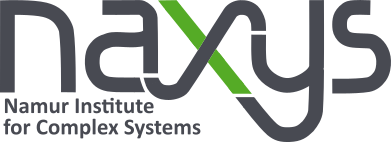BENet – PROGRAM
Program
9h10-9h30 Registration & Coffee
9h30-9h40 Welcome & Opening Remarks Anne-Sophie Libert (director of naXys) & Timoteo Carletti (chair organizer)
9h40-10h40 Session 1 – Chair Pietro Coletti (Hasselt Universiteit)
* Universal scaling of social interactions across animal species – Luis Rocha (Gent Universiteit)
* Node-edge relationship in ecological networks and their robustness to node removals – Camille Carpentier (Université de Namur)
* On the training of sparse and dense deep neural networks: less parameters, same performance – Lorenzo Chicchi (Università di Firenze)
10h40-11h00 Coffee Break
11h00-11h50 Keynote 1 – Chair Timoteo Carletti (Université de Namur)
* Online Higher-order networks and their dynamics – Ginestra Bianconi (Queen Mary University of London)
11h50-12h10 Lightning Session – Chair Lorenzo Giambagli (Université de Namur & Università di Firenze)
* Topological features of EEG and hypnotisability – Maxime Lucas (ISI Foundation Torino)
* Lightning Round of Poster Presentations
12h10-13h40 Lunch & Poster Session
13h40-14h30 Keynote 2 – Chair Roma Siugzdaite (Gent Universiteit & University of Cambridge)
* Signal processing on graphs and simplicial complexes – Michael Schaub (RWTH Aachen Universität)
14h30-15h30 Session 2 – Chair Luca Gallo (Université de Namur & Università di Catania)
* Spectral Pruning of Fully Connected Layers: Ranking the Nodes Based on the Eigenvalues – Lorenzo Giambagli (Université de Namur & Università di Firenze)
* A Diffusion Approximation to the Competition-Induced Criticality Model – Kleber Oliveira (University of Limerick)
* Dimension reduction of complex networks to address critical transitions on lowdimensional manifolds – Daniele Proverbio (University of Luxembourg & University of Exeter)
15h30-16h00 Coffee Break & Poster Session
16h00-17h00 Session 3 – Chair Danai Kafetzaki (KU Leuven)
* Online Connecting dots and pots: Integrating network science and pottery studies in archaeology – Dries Daems (Middle East Technical University & KU Leuven)
* The impact of social contact networks on innovation and creation of new ideas – Fatemeh Zarei (Gent Universiteit)
* Beyond pairwise network similarity: exploring Mediation and Suppression between networks – Daniele Marinazzo (Gent Universiteit)
17h00-17h50 Keynote 3 – Chair Riccardo Muolo (Université de Namur)
* Online Network inference via process motifs for lagged correlation in linear stochastic processes – Alice Schwarze (University of Washington)
17h50-18h00 Closing Remarks
Posters
* Phase transition induced by non-linear random walks on lattices – Jean-François de Kemmeter (Université de Namur)
* Maximum Entropy applied on Twitter disinformation datasets – Bart de Clerck (Royal Military Academy & Gent Universiteit)
* Convolutional Neural Networks for image analysis – Valentin Delchevalrie (Université de Namur)
* Selecting controlled nodes to reduce network synchronization – Martin Moriamé (Université de Namur)
* Finite propagation enhances Turing patterns in reaction-diffusion networked systems – Riccardo Muolo (Université de Namur)
* Lack of practical identifiability may hamper reliable predictions in COVID-19 epidemic models – Luca Gallo (Université de Namur & Università di Catania)
* Geometrical description of the argument of weak values of general observables in therms of SU(N) generators – Lorena Ballesteros Ferraz (Université de Namur)
* Effects of local interactions in epidemis outbreaks in networks of structured populations – Cédric Simal (Université de Namur)
* WAL-SAT (WALlonia Space Awareness Technology): network theory and machine learning approach for space traffic management – Matteo Romano (Université de Namur)
Keynote speakers
- Ginestra Bianconi (Queen Mary University of London), High-order networks and their dynamics
Higher-order networks describe the many-body interactions of a large variety of complex systems, ranging from the brain to collaboration networks and social contact networks. Simplicial complexes are generalized network structures which allow us to capture the combinatorial properties, the topology and the geometry of higher-order networks. In this talk we will show that simplicial complexes provide a very general mathematical framework to reveal how higher-order dynamics including synchronization and epidemic spreading depends on simplicial network topology. We will show that higher-order synchronization describing the dynamics of topological signals defined on links, triangles and higher-dimensional simplices is explosive and we will show that this rich dynamics can have an important role for understanding brain rhythms. We will also show how epidemic spreading on higher-order networks can take into account for time-dependent contacts due to co-location in space and how this modelling can help us understand the spreading dynamics of airborne diseases. - Michael Schaub (RWTH Aachen University), Signal processing on graphs and simplicial complexes
We are confronted with signals defined on the nodes of a graph in many applications. Think for instance of a sensor network measuring temperature; or a social network, in which each person (node) has an opinion about a specificissue. Graph signal processing (GSP) tries to device appropriate tools to process such data by generalizing classical methods from signal processing of time-series and images — such as smoothing, filtering and interpolation — to signals defined on graphs. Typically, this involves leveraging the structure of the graph as encoded in the spectral properties of the graph Laplacian.
In other applications such as traffic network analysis, however, the signals of interest are naturally defined on the edges of a graph, rather than on the nodes. After a very brief recap of the central ideas of GSP, we examine why the standard tools from GSP may not be suitable for the analysis of such edge signals. More specifically, we discuss how the underlying notion of a ‘smooth signal’ inherited from (the typically considered variants of) the graph Laplacian are not suitable when dealing with edge signals that encode flows. To overcome this limitation we devise signal processing tools based on the Hodge-Laplacian and the associated discrete Hodge Theory for simplicial (and cellular) complexes. We discuss applications of these ideas for signal smoothing, semi-supervised and active learning for edge-flows on discrete (or discretized) spaces. - Alice C. Schwarze (University of Washington), Network inference via process motifs for lagged correlation in linear stochastic processes
Many existing methods for causal inference from time-series data require (1) stationary or de-trended input data, which can make it difficult to infer networks from observations of dynamical systems with slow mean-reversion, and (2) a trade-off between scalability and accuracy, which can make it difficult to infer large networks. We demonstrate that for time-series data of a linear stochastic system with slow mean-reversion, commonly used pairwise edge-likelihood measures (PELMs) including Granger causality, transfer entropy, and convergent crossmapping do not lead to a much higher accuracy of inferred networks than lagged correlation.
Using process motifs for a linear stochastic process, we derive two new PELMs that aim to improve the inference accuracy of lagged correlation by correcting lagged correlation for confounding factors and reverse causation. For linear stochastic systems, our proposed PELMs are fast, accurate, and easy-to-implement methods for network inference with a clear theoretical underpinning. They provide a promising alternative to commonly used inference methods, such as Granger causality, vector-autoregression, and sparse inverse covariance estimation.

